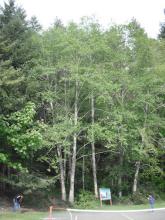
Image Credit: DANA KELLEY BRESSETTE
Family: Betulaceae
Common name(s): Red alder
General bloom time: early spring, tree will flower with red blossoms
Identification: deciduous tree; can reach nearly 25 feet in height; bark is thin, grey, and smooth often with patches of lichens; wood turns red when cut
Leaves: alternate; broadly elliptic and sharp-pointed at the base and tip; can be anywhere from 5-15 cm long; dull green and smooth above and rust-colored and hairy below; margins are wavy and slightly rolled under; coarse, blunt teeth; leaves remain mainly green until they drop in the late fall
Fruit: clusters of brownish cones to 2 cm long; contain oval, winged nutlets
Habitat: prefers moist woods and streambanks and recently cleared lands; low elevations
Ecology: Western tiger caterpillars eat the leaves.
/index.jpg?itok=VV0mTWEf)
Image Credit: Marvin Kellar
Fun Facts:
- Considered the best wood for smoking salmon
- The bark was renowned for its medicinal qualities
Places to find in Portland: Forest Park
References:
Pojar, J. & A. MacKinnon. 1994. Plants of the Pacific Northwest Coast: Washington, Oregon, British Columbia & Alaska. Vancouver B.C., Lone Pine Publishing.
http://plants.usda.gov/java/nameSearch?keywordquery=Alnus+rubra&mode=sciname&submit.x=0&submit.y=0